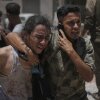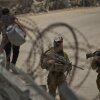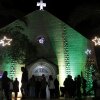On Sunday, the Syrian government security forces block the Bedouin fighters, the bottom, from the province of Sweida, in the village of Busra al-Harir, in southern Syria.
Omar Sanadiki / AP
hide
tilting legend
Omar Sanadiki / AP
Mazraa, Syria-The Armed Bedouin clans of Syria announced on Sunday that they had withdrawn from the city of Druze-Majority City of Sweida after the clashes of a week and an American-based cease-fire, while the convoys of humanitarian aid began to enter the battered southern city.

The clashes between the militias of the religious minority of Druze and the Sunni Muslim clans killed hundreds and threatened to untangle the already fragile post-war transition from Syria. Israel has also launched dozens of air strikes in the province of Druze-Majority Sweida, targeting government forces that had actually arranged with the Bedouins.
The clashes have also led to a series of targeted sectarian attacks against the Druze community, followed by revenge attacks against the Bedouins.
A series of Tit-For-Tat kidnappings sparked clashes in various cities and villages in the province, which then spread to the city of Sweida, the provincial capital. Government forces were redeployed to interrupt the renewed battles that broke out Thursday, before retiring again.
The acting president Ahmad al-Sharaa, who was perceived as more sympathetic for the Bedouins, had tried to call on the community of Druze while remaining criticizing the militias. He then urged the Bedouins to leave the city, saying that they “cannot replace the role of the State in the management of the country’s business and the restoration of security”.
“We thank the Bedouins for their heroic positions, but demand that they fully engage in the ceasefire and comply with the orders of the state,” he said in an address broadcast on Saturday.
Dozens of armed Bedouin fighters alongside other clans in the whole country that came to support them remained on the outskirts of the city and were completed by government security forces and the military police. They blame the clashes on the factions of Druze faithful to the spiritual leader Sheikh Hikmat al-Hijri and accuse them of harming Bedouin families.
“We will not leave before he turns alongside those who tried to remove the sedition. And it is only then that we will return home.” Khaled al-Mohammad, who came to the southern province alongside other tribes in the eastern province of Deir al-Zour, told the Associated Press.
Help convoys enter Sweida but tensions persist
The withdrawal of the Bedouins brought cautious calm in the region, with humanitarian convoys on their way. The Syrian red crescent said on Sunday that it had sent 32 trucks loaded with food, medication, water, fuel and other aid, after the fighting left the province of cuts and shortages.
The state agency of the State of Syria, Sana, reported that the convoy had entered Sweida on Sunday, but accused Al-Hijri and its supporters of Druze armed to have returned a government delegation which accompanied another convoy.
The Ministry of Foreign Affairs, in a statement, said that the convoy accompanying the delegation had two ambulances responsible for aid provided by local and international organizations.

Al-Hijri did not react directly to the accusations, but said in a statement that he welcomed aid to Sweida and criticized what he claims to have been distorted against him.
“We reaffirm that we have no dispute with anyone on a religious or ethnic basis,” said the press release. “Shame and shame are on all those who seek to sow discord and hatred in the minds of young people.”
The United Nations International Migration Organization said that 128,571 people had been moved during clashes, including only 43,000 on Saturday.
The American envoy called upon the end of the fighting
Washington’s special envoy in Syria Tom Barrack said that clashes and atrocities “eclipse” a first prudent optimism on the post-war transition from the country and the lifting of sanctions by the international community.
“All factions must immediately lay down their arms, stop hostilities and abandon tribal revenge cycles,” said Barrack on X. “Syria is at a critical moment – peace and dialogue must prevail – and prevail now.”
Among the people killed in one -week fights, there were dozens of civilians Druze killed in a series of targeted attacks in the city in the hands of Bedouin fighters and government forces. Videos have surfaced online of fighters destroying portraits of religious leaders of Druze and notables in houses, and shaving the mustaches of elderly Druze, considered an insult to culture and tradition. The militias of Druze in return attacked the Bedouin majority areas on the outskirts of the province, forcing families to flee to the neighboring province of Daraa.
More than half of about 1 million Druze worldwide live in Syria. Most of the other Druze live in Lebanon and Israel, including in the Golan Heights, which Israel captured from Syria in the 1967 Middle East war and annexed in 1981.

The Druze of Syria largely celebrated the fall of the Assad family which ended decades of tyrannical rule. Although they have concerns about the de facto Islamist rule of Al-Sharaa, many wanted to tackle things diplomatically. Al-Hijri and his supporters, however, adopted a more conflicting approach with Al-Sharaa, unlike most of the other figures of influential Druze. Critics also note the previous allegiance of Al-Hijri to Assad.
However, recent clashes and sectarian attacks against the minority community have made an increasing number of Druze in the region more skeptical about the new management of Damascus and more doubtful of peaceful coexistence.



